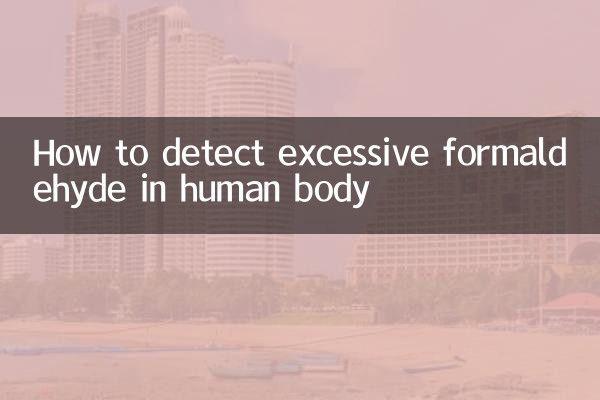How to detect excessive formaldehyde in human body?
Formaldehyde is a common indoor air pollutant. Long-term exposure to high concentrations of formaldehyde may cause serious harm to human health. In recent years, the problem of excessive formaldehyde has attracted much attention, especially in scenes such as newly renovated houses and new cars. This article will introduce in detail the detection method of human formaldehyde exceeding the standard, and provide structured data for reference based on hot topics across the Internet in the past 10 days.
1. The harm of excessive formaldehyde

Formaldehyde is a colorless gas with a pungent odor. Long-term exposure may cause the following health problems:
| Hazard type | Specific performance |
|---|---|
| short term exposure | Eye irritation, throat discomfort, headache, nausea |
| long term exposure | Decreased immunity, increased risk of respiratory diseases, and leukemia |
| Special groups | Pregnant women may cause fetal malformations and children may develop asthma |
2. Detection method for excessive formaldehyde in human body
To detect whether formaldehyde exceeds the standard in the human body, you can start from the following aspects:
| Detection method | Operation mode | Advantages and Disadvantages |
|---|---|---|
| blood test | Blood test for formaldehyde content through hospital blood test | High accuracy, but expensive |
| urine test | Collect urine samples to detect formaldehyde metabolites | Non-invasive and suitable for large-scale screening |
| Exhaled breath testing | Analysis of formaldehyde in exhaled air by special equipment | Fast and convenient, but limited accuracy |
| Symptom observation | Judgment based on physical discomfort symptoms | Highly subjective and needs to be combined with other tests |
3. Popular formaldehyde-related topics on the Internet in the past 10 days
Combined with the Internet hot spots in the past 10 days, the following is the formaldehyde-related content of public concern:
| Hot search keywords | attention index | Main discussion content |
|---|---|---|
| Formaldehyde in new cars exceeds standard | 856,000 | High temperatures in summer lead to increased formaldehyde release in cars |
| Formaldehyde testing in rental housing | 723,000 | Formaldehyde safety issues during graduate rental season |
| Formaldehyde self-test box | 689,000 | Discussion on the reliability of household formaldehyde detection tools |
| Formaldehyde removal method | 654,000 | The scientific nature and effectiveness of various formaldehyde removal methods |
4. Suggestions for preventing and improving formaldehyde exceeding the standard
In response to the problem of excessive formaldehyde, the following are effective prevention and improvement measures:
| Measure type | Specific methods | Effect evaluation |
|---|---|---|
| Ventilation | Maintain indoor air circulation | The most cost-effective basic method |
| air purification | Use a professional air purifier | The effect is remarkable but the filter element needs to be replaced regularly |
| Plant adsorption | Place plants such as pothos and spider plants | Auxiliary effect, limited effect |
| Professional governance | Hire a professional aldehyde removal company | Best effect but higher cost |
5. Protection recommendations for special groups of people
For special groups such as pregnant women, children, and the elderly, special attention needs to be paid to formaldehyde protection:
1.pregnant woman: It is recommended to conduct professional testing before moving in. The formaldehyde concentration should be less than 0.06mg/m³
2.children: Avoid using high-formaldehyde-emitting materials such as density boards in children’s rooms.
3.old man: The elderly have weak resistance and should ensure that formaldehyde in the bedroom meets the standard.
4.People with allergies: People who are sensitive to formaldehyde should minimize their exposure to the newly decorated environment
6. Clarification of common misunderstandings
Regarding formaldehyde detection and treatment, the public has some common misunderstandings:
1."Safe without smell": Formaldehyde may be odorless at low concentrations, but still harmful
2."Activated Carbon Universal": Activated carbon will be saturated and needs to be replaced regularly.
3."Once treated, it will last forever": Formaldehyde release is a long-term process that requires continuous attention
4."The more expensive the price, the better the effect.": The selection of detection methods should be based on actual needs
Conclusion
The harm of excessive formaldehyde to human health cannot be ignored. Through scientific detection methods and effective protective measures, we can greatly reduce the health risks caused by formaldehyde. It is recommended that newly renovated houses be ventilated for at least 3-6 months and undergo professional testing before moving in. For people who already have symptoms of discomfort, they should seek medical treatment promptly and have the formaldehyde content in their bodies tested. Only by staying vigilant and taking scientific protection can we ensure the health and safety of our living environment.

check the details

check the details